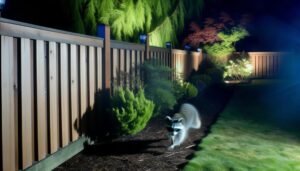How Do Raccoons Get Into Cabinets and Prevent Them?
Raccoons access cabinets using their exceptional climbing skills and highly dexterous front paws. These mammals can exploit small gaps and cracks around cabinetry, making use of their problem-solving abilities to navigate and enter confined spaces.
Their nocturnal nature heightens their activity at night, seeking food and shelter. Common entry points include spaces around plumbing, gaps in walls, and poorly secured cabinet doors.
Securing these entry points with heavy-duty latches and using deterrents such as motion-activated lights can prevent raccoons from gaining access. Understanding their behaviors and preventive measures is pivotal for effective control.
Discovering more strategies can enhance protection measures.

Key Takeaways
- Raccoons exploit gaps and cracks around cabinets to gain entry.
- Their dexterous front paws enable them to manipulate and open cabinet doors.
- They can climb and reach elevated cabinets with ease.
- Raccoons' nocturnal activity often leads them to explore indoor spaces at night.
- Cabinets left unsecured or without proper latches are easily accessed by raccoons.
Raccoons' Natural Curiosity
Raccoons are inherently curious creatures, driven by an instinctive need to explore their surroundings in search of food and shelter. This natural curiosity is a fundamental survival trait that enables raccoons to adapt to various environments. They exhibit exploratory behaviors that are both deliberate and systematic, often investigating potential food sources and safe havens.
This inquisitiveness is particularly evident when raccoons encounter human habitats, as they are adept at identifying opportunities for scavenging. Their acute sense of smell and tactile sensitivity guide them towards food, prompting them to investigate cabinets and other enclosed spaces.
Understanding these behaviors is essential for developing effective strategies to manage raccoon intrusions and mitigate potential conflicts between raccoons and human inhabitants.
Physical Abilities of Raccoons
Raccoons possess extremely dexterous front paws, allowing them to manipulate objects with considerable precision.
Additionally, their exceptional climbing and balancing skills enable them to navigate complex environments with ease.
These physical abilities greatly contribute to their ability to access and explore cabinets in residential settings.
Dexterous Front Paws
The dexterous front paws of raccoons exhibit remarkable manipulative abilities, allowing them to grasp and manipulate objects with a high degree of precision. These paws are equipped with five long, flexible digits, similar to human hands, which enable raccoons to perform intricate tasks such as opening latches and turning knobs.
Each digit is highly sensitive, providing raccoons with tactile feedback that enhances their ability to discern textures and shapes. Moreover, the rotational capacity of their wrists allows for a wide range of motion, facilitating complex maneuvers.
This combination of flexibility and sensitivity makes raccoons particularly adept at accessing food sources in cabinets, underscoring the importance of securing household storage areas to prevent wildlife intrusions.
Climbing and Balancing Skills
Possessing exceptional climbing and balancing skills, these nocturnal mammals demonstrate remarkable agility in traversing complex environments. Raccoons exhibit physical abilities that enable them to navigate vertical surfaces and narrow ledges with ease. Their robust musculature and sharp claws facilitate effective grip and climbing efficiency. Moreover, their keen sense of balance allows them to maneuver through precarious spaces without falling.
Key physical attributes include:
- Flexible Ankles: Raccoons can rotate their hind feet 180 degrees, aiding in descending headfirst.
- Strong Limbs: Their powerful limbs support significant weight and provide the necessary strength for climbing.
- Tactile Sensitivity: Enhanced sensory perception in their paws aids in grasping and manipulating objects.
These combined traits make raccoons adept at accessing confined spaces, such as cabinets.
Dexterous Paws
With remarkable agility, raccoon paws exhibit a level of dexterity comparable to that of primates. Each paw contains five digits, equipped with sharp claws and a highly developed sense of touch, enabling raccoons to manipulate objects with precision.
This anatomical feature allows them to open latches, turn knobs, and even untie knots. The tactile sensitivity of their paws is further enhanced by the presence of specialized nerve endings, which contribute to their ability to discern textures and shapes.
These capabilities are essential for accessing food sources, including those contained within cabinets. The combination of dexterous paws and tactile acuity enables raccoons to overcome physical barriers, making them particularly adept at infiltrating human dwellings in search of sustenance.
Problem-Solving Skills
Raccoons exhibit advanced problem-solving skills, often utilizing trial and error methods to navigate complex challenges in their quest for food. Their cognitive abilities are comparable to those of primates, enabling them to access cabinets, open containers, and manipulate latches with remarkable dexterity. These skills are honed by their natural curiosity and persistence.
Key aspects of their problem-solving abilities include:
- Adaptability: Raccoons can adjust their strategies based on the specific obstacles they encounter.
- Memory: They remember successful methods and apply them to similar situations in the future.
- Tool Use: Although not common, raccoons have been observed using objects to achieve their goals.
Understanding these capabilities is essential for devising effective prevention strategies to keep raccoons out of cabinets.
Common Entry Points
Understanding common entry points is essential in preventing raccoons from accessing cabinets. Primary entry points include gaps and cracks in the building structure as well as open windows.
Identifying and securing these vulnerabilities can greatly reduce the likelihood of raccoon intrusions.
Gaps and Cracks
Gaps and cracks around cabinets provide accessible entry points for raccoons, allowing them to infiltrate indoor spaces in search of food and shelter. These small openings can often go unnoticed, yet they offer raccoons sufficient access due to their dexterous paws and slender bodies. Raccoons are adept at exploiting structural vulnerabilities in homes, making it imperative to regularly inspect and repair any potential entry points.
Key areas to examine include:
- Spaces around plumbing or electrical conduits: These gaps can provide direct pathways into kitchens and other areas.
- Cracks in the foundation or walls: Even minor fissures can be enlarged by raccoons.
- Gaps in roof eaves or soffits: These can lead to attic spaces, from which raccoons can descend into cabinets.
Regular maintenance and prompt repairs are essential in preventing raccoon intrusions.
Open Windows
Open windows serve as one of the most accessible entry points for raccoons seeking to enter homes. These nocturnal mammals possess exceptional climbing abilities, enabling them to reach even second-story windows.
Once inside, raccoons exploit their dexterous forepaws to navigate through cabinets and other enclosed spaces. The presence of open windows, particularly those without screens, creates an inviting pathway for these opportunistic creatures.
To mitigate this risk, it is crucial to make sure windows are securely closed or fitted with robust screens, especially at night. Additionally, homeowners should be vigilant about repairing damaged screens promptly.
Taking these preventive measures can greatly reduce the likelihood of raccoons intruding into homes and subsequently gaining access to cabinets.
Weak Spots in Cabinets
Identifying the weak spots in cabinets is essential for preventing raccoons from gaining access to stored items. Structural vulnerabilities often exist in the form of aged wood, loose hinges, and compromised seals, which raccoons can exploit due to their dexterity and strength.
Key areas to inspect include:
- Cabinet Doors: Check for gaps or weaknesses in the hinges and latches. Raccoons can easily pry open poorly secured doors.
- Seals and Edges: Confirm that seals around the edges are intact to prevent raccoons from using their claws to create entry points.
- Back Panels: Examine the rear of the cabinets for any loose or damaged panels that could be pushed or pulled away.
Addressing these weak spots can greatly reduce the risk of raccoon intrusion.
Signs of Raccoon Intrusion
Once the structural vulnerabilities have been addressed, it is important to recognize the signs of raccoon intrusion to confirm ongoing cabinet security. Key indicators include physical damage such as scratches, bite marks, or displaced cabinet doors. Additionally, the presence of raccoon fur or excrement can validate their activity.
Auditory cues, such as scratching or thumping sounds, often signal nocturnal exploration. Inspect for displaced or torn food packaging, as raccoons tend to forage aggressively. Olfactory evidence, such as an unusual musky odor, may also suggest their presence.
Regularly monitoring these signs can help maintain cabinet integrity and validate swift intervention, promoting a secure environment for storing goods and protecting household welfare.
Nighttime Activity Patterns
Raccoons display distinct nocturnal activity patterns, typically becoming most active shortly after dusk and continuing their foraging behaviors until dawn. This nocturnal behavior is driven by their crepuscular nature, which allows them to avoid diurnal predators and human disturbances.
During these nocturnal hours, raccoons engage in activities such as:
- Foraging: Searching for food, which may include rummaging through garbage or entering homes to access cabinets.
- Social interactions: Communicating and interacting with other raccoons, often establishing territories or mating.
- Exploration: Investigating new environments and potential shelter sites.
Understanding these activity patterns is essential for addressing raccoon intrusions effectively. Their nocturnal habits underscore the importance of implementing strategies during these key active periods to mitigate potential conflicts.
Preventive Measures
To mitigate the issue of raccoons infiltrating cabinets, it is important to implement effective preventive measures.
Ensuring that cabinet doors are securely fastened can greatly reduce accessibility for these animals.
Additionally, the installation of raccoon deterrents, such as motion-activated lights or repellents, can further discourage their presence in household environments.
Secure Cabinet Doors
Securing cabinet doors is essential for preventing raccoons from gaining access to stored items and causing potential damage. Effective measures must be taken to make sure that cabinet doors remain firmly closed, especially in areas susceptible to raccoon intrusion.
To achieve this, several practical solutions can be implemented:
- Install child-proof locks: These locks provide an additional barrier that is challenging for raccoons to manipulate.
- Use heavy-duty latches: Strong latches can withstand the force exerted by raccoons attempting to pry open the doors.
- Apply magnetic catches: These catches offer a firm hold, making it difficult for raccoons to open the cabinets.
Install Raccoon Deterrents
In addition to securing cabinet doors, implementing raccoon deterrents can also help reduce the likelihood of these animals infiltrating indoor spaces. Effective deterrents include ultrasonic repellents, which emit high-frequency sounds to dissuade raccoons without disturbing humans.
Additionally, motion-activated lights can startle and discourage raccoons from approaching entry points. Furthermore, chemical deterrents containing capsaicin or predator urine can be strategically placed at potential entry sites.
For outdoor areas, securing trash bins with raccoon-proof lids and removing food sources can minimize attraction. Ensuring that vents, chimneys, and other structural openings are adequately sealed with metal mesh can also be effective.
These preventive measures collectively enhance the overall efficacy of raccoon exclusion strategies, thereby promoting a raccoon-free environment.
Securing Your Cabinets
Effective measures to fortify your cabinets are crucial in preventing raccoons from gaining access to food and other items stored within. Properly securing cabinets minimizes the risk of contamination and damage.
To achieve this, consider implementing the following strategies:
- Install Childproof Locks: These devices are simple yet impactful in preventing raccoons from opening cabinet doors.
- Use Heavy-Duty Latches: Opt for metal latches that can withstand the strength and dexterity of raccoons.
- Seal Gaps and Cracks: Ensure there are no entry points around the cabinets that raccoons can exploit.
These steps will notably reduce the likelihood of raccoons infiltrating your cabinets. Employing these measures is a practical approach for maintaining a secure and hygienic environment.
Professional Help
If the above-mentioned methods prove inadequate, enlisting professional assistance can offer a more thorough solution for raccoon infestations. Professional wildlife control services employ trained technicians who utilize specialized equipment and techniques to safely and humanely remove raccoons.
These experts can conduct a detailed inspection to identify entry points and potential attractants within the home environment. Their methodologies often include trapping, exclusion, and habitat modification to ensure long-term prevention.
Additionally, licensed professionals adhere to local regulations and ethical guidelines, ensuring that both the animals and residents are treated with respect and care. Engaging professional services not only resolves the immediate issue but also provides educational insights on preventing future incursions, fostering a safer and more secure living environment.
Conclusion
The cunning and resourcefulness of raccoons in gaining entry to cabinets is a proof of their remarkable adaptability. Their skillful paws, combined with advanced problem-solving skills, enable them to exploit common vulnerabilities in household structures.
With their nocturnal activity patterns, raccoons often go unnoticed until significant damage is done. The question remains: can human ingenuity outpace their relentless curiosity and tenacity?
The answer lies in diligent preventive measures and, when necessary, enlisting professional assistance.






